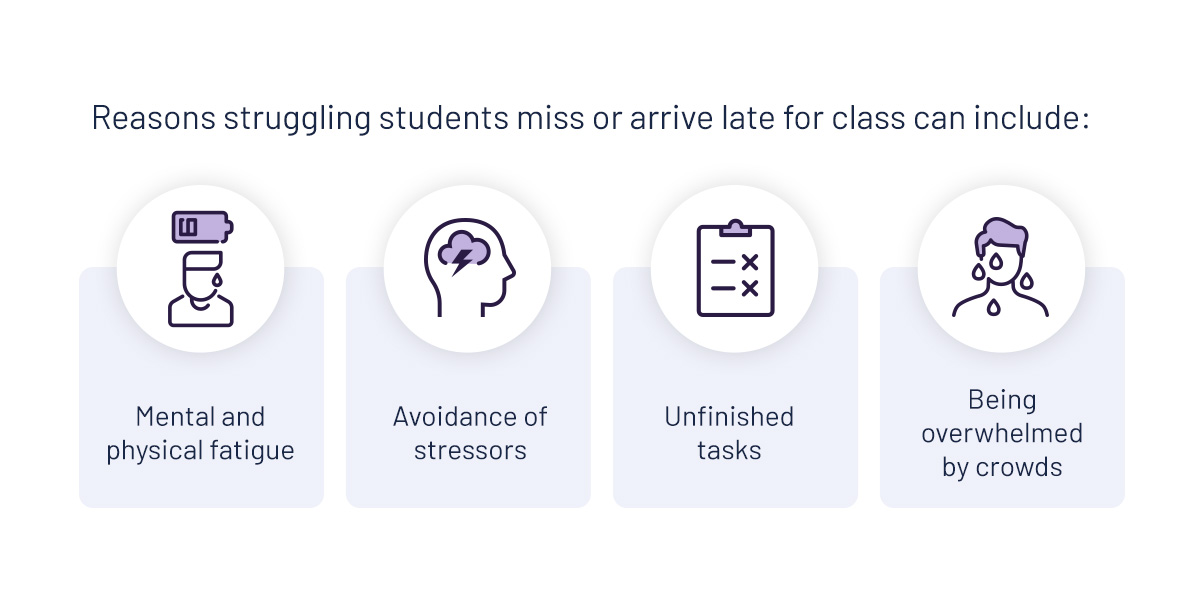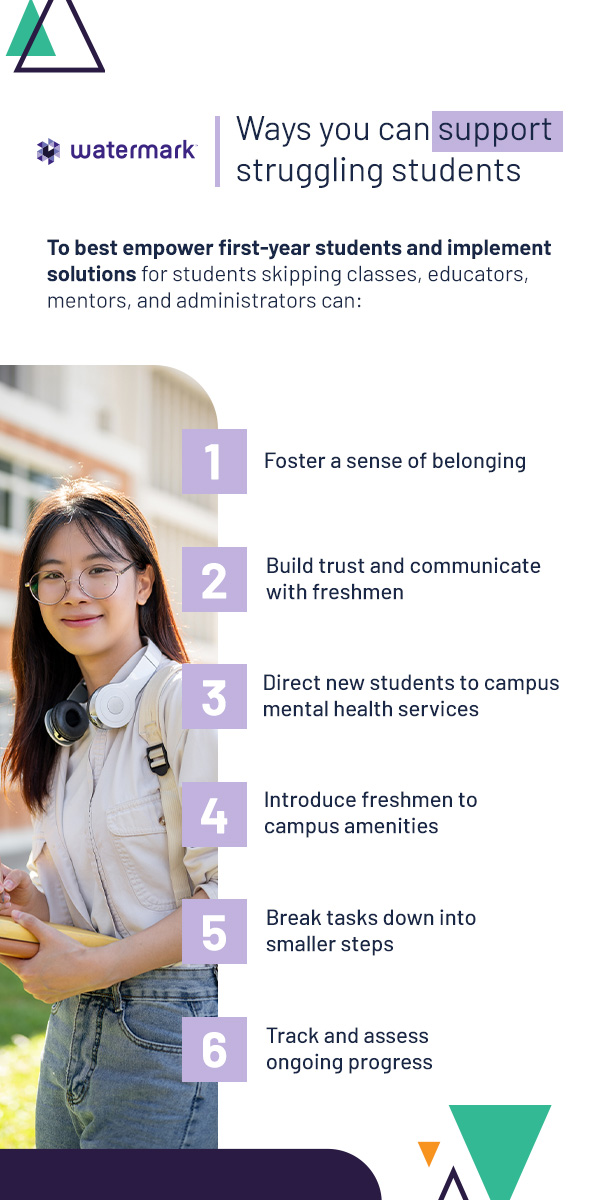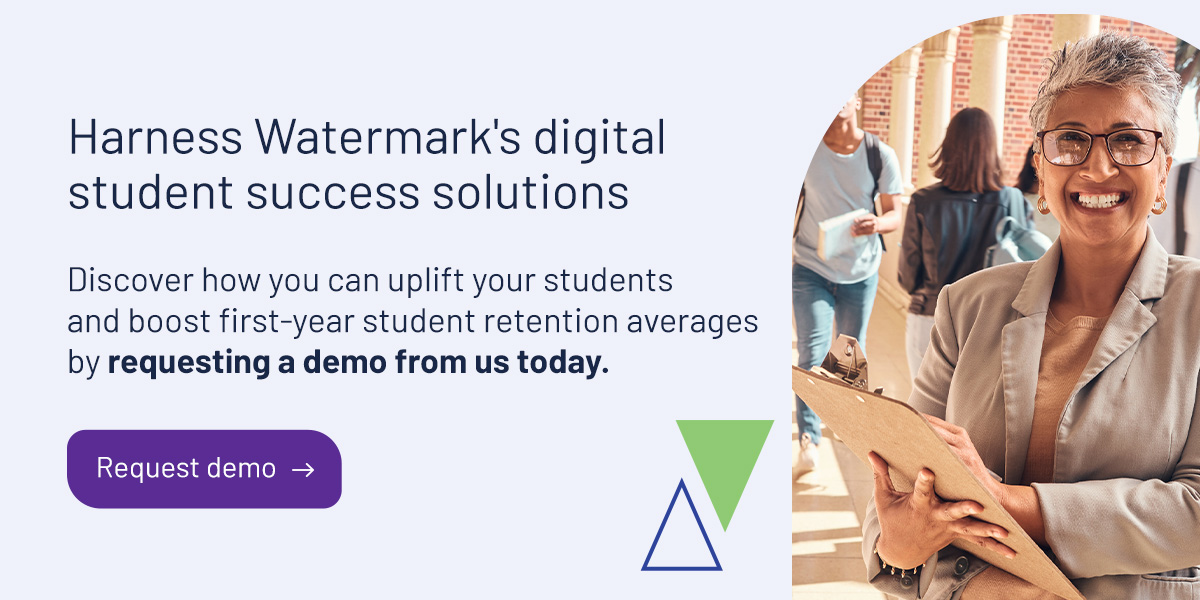




For freshmen, the first year of tertiary studies offers exhilarating changes, challenges, and choices. Once the novelty and excitement of the first few weeks have subsided, however, some students start feeling the pressure and struggle to adjust. Fortunately, higher education institutions can help first-year students adapt to their new situation and achieve academic success with compassionate support and helpful tools.
As any new college student or their parent will tell you, adapting to life in higher education can take some getting used to, and some students find it more trying than others. New living situations, sudden independence, more challenging coursework, and different social dynamics all play a role in freshmen students struggling in their first few months of school. Pivotal triggers and stressors include:
For many freshmen, college is their first time living away from their family home, moving towns, states, or even countries to attend their chosen institution. Independent living is often a significant change and takes courage and tenacity. Their privacy and stimulation levels may also differ if they stay in bustling dormitories or rent an apartment with roommates.
Getting used to new surroundings and feeling comfortable in unfamiliar territory takes a while. On campus, students may not know how to find essential locations like lecture buildings or administrative offices, and this disorientation can create nerves, insecurity, and logistical snags like missed tutorials or clerical issues. While most students will quickly memorize their way around campus, the first few months are a significant learning curve.
Students who move far distances to attend school face other challenges, such as getting used to the climate in their new town, switching their language of instruction, and learning area conventions, such as how to use public transport. They may also have to adjust to cultural differences like food traditions, social norms, polite customs, and dressing preferences. All these new facets of life can feel overwhelming to a first-year student.
Higher learning institutions often require students to manage their own time, which isn’t always easy, especially in the beginning. Before graduating, most learners had relatively consistent routines monitored and enforced by guardians, teachers, and coaches. However, they have much more freedom and responsibility once they start tertiary education.

In their first year of university or college, young adults face competing priorities, including spending time with friends and family, attending classes, studying for exams, practicing self-care, working, and participating in extracurricular activities. If students don’t plan their daily movements and stick to that plan, they risk neglecting meaningful parts of their lives, getting minimal sleep, eating too little, being late or absent, and becoming swamped with tasks.
The academic standard rises significantly between high school and college, and students often arrive with the expectation that their grades will stay consistent despite the jump in difficulty. They may feel thrown off by the high workload and unduly chastise themselves for not achieving immediate academic success. If not addressed, this self-inflicted pressure can trigger anxiety, procrastination, avoidance, a drop in confidence, and even depression.
It’s also possible that students realize early on that they aren’t as passionate about the subjects they’ve chosen to study as they previously thought. If someone has dreamed of becoming an engineer since childhood but discovers they don’t like any of the required subjects, that could lead to a career path crisis and a host of psychological and emotional troubles.
University and college students enter a new social paradigm when they move from high school to tertiary education. Orientation is an excellent opportunity for first-year students to meet people and start building new relationships, although students often still miss their friends and family back home. After orientation, it’s up to the students to take the initiative and set up a social circle for themselves, which can daunt introverted or shy people.
Social media also puts added pressure on first-year students. Their feeds show idealized images of happy college-age people enjoying hangouts and parties with friends, exploring campus amenities, and thriving in class. While these curated images rarely reflect reality, students often compare themselves to their online peers and may feel they’re not making the most of their opportunities or succeeding enough.
According to Gallup and Lumina Foundation’s State of Higher Education 2024 Report, 64 percent of currently enrolled students who recently thought about leaving their program cited emotional stress or mental health issues as major influencing factors. Also, 55 percent of unenrolled individuals aged 18 to 25 cited these factors as critical reasons for not enrolling in college. These figures highlight a growing need for on-campus support, particularly for first-year students.
Administrators and educators can look for specific signs when assessing whether a student is finding adapting too challenging and needs support. Behavioral and emotional changes often reveal more profound struggles that students don’t outwardly express. For their well-being, mental health, academic success — and their institution’s first-year student retention averages — students need faculty to look out for them. Some tell-tale behaviors include:
Freshmen students skipping class indicates that something is out of balance in their lives. While a handful of cases could be due to time mismanagement, many students may be suffering from anxiety or depression and the executive dysfunction that they bring about. Reasons struggling students miss or arrive late for class can include:

Sleep is essential for good mental health and good academic performance. Stress and overwork can impact sleep quality, and poor sleep quality can lead to further stress and work efficiency decline, creating a challenging, self-perpetuating cycle. If you or another faculty member notice students sleeping in class, lacking focus, consistently missing early classes, or exhibiting signs of exhaustion, they may need mental health support.
Anxiety can give students the adrenaline and impetus they need to get assignments done, but it can also instill feelings of paralysis. Similarly, depression can disrupt focus and motivation, leading to unfinished tasks. The more deadlines struggling students miss, the more behind they get on the coursework and the more stress and guilt they build up, creating another disempowering cycle.
While you can’t determine a person’s mental state simply by looking at them, some maladaptive behaviors can give clues on how they’re doing emotionally and psychologically. Not every anxious behavior necessarily means a student is facing mental health concerns, but if the behaviors endure, worsen, or compound, there’s a higher chance they’re from internal struggles. Some indicators to watch for include:
Student grades can drop for various reasons, including emotional distress and difficulty keeping up with the new academic standard. Reduced class attendance, incomplete homework, unfinished assignments, compromised focus during lectures, and general fatigue can all contribute to a struggling student’s academic performance slipping. This dip is especially difficult for students with perfectionistic tendencies, leading to more stress.
Higher education institutions must create policies and offer resources that help support struggling students on a broader scale. On a more personal level, faculty members can help students overcome their first-year hurdles with a good balance of empathy, professionalism, and institution-specific knowledge. To best empower first-year students and implement solutions for students skipping classes, educators, mentors, and administrators can:

New students are often under the false impression that their feelings of isolation and uncertainty are unique to them, as though their anxieties make them outsiders to the smooth status quo. Conversely, these feelings are common among first-year students. Understanding that their peers share their feelings can help students realize that their social and academic insecurities help define their belonging, not their otherness.
Lewis & Clark College implemented a social-belonging intervention based on Stanford University research to help first-year students navigate the challenges of transitioning to college. They used an online orientation exercise that required new students to read and reflect on stories from others who faced similar academic and social hurdles. This way, they realized they were not the exception and were instead experiencing typical growing pains.
Institutions need an open line of effective communication with their students to best support them and provide helpful resources. It’s also critical that students know their efforts are seen and appreciated and have mentors willing to advise and guide them through challenges. While face-to-face interactions are certainly helpful, the number of students in need can outweigh the time educators and advisors have to offer.
Fortunately, digital communication is becoming an increasingly popular way of liaising with students, and data-driven, insights-based software can revolutionize the quality of text-based student support. Student success and engagement solutions with an integrated mobile app can help your institution personalize communication, schedule meetings, facilitate peer-to-peer and mentor communication, and assist with registration.
Higher education institutions must inform new students of all the available online and on-campus counseling resources when they arrive. Advisors and mentors can distribute literature at orientation events, use bulletin boards, send emails, and even provide online platforms with a central hub of support resources for streamlined student access.
It’s also critical for campus staff to learn the signs of a struggling first-year student so they can take action quickly and intervene before issues become unmanageable. Lecturers, tutors, student leadership, administrators, academic advisors, dormitory facilitators, and other faculty members should be up to date with all the available mental health services and tactfully offer them to students in need.
Campus amenities like academic advisory facilities, cultural and hobby clubs, sports teams, LGBTQIA+ safe spaces, and student leadership organizations can help first-year students assimilate, meet like-minded peers, and feel more comfortable in their new environment. Events based on their interests give students something to look forward to and introduce them to more of the campus, its culture, and its people.
Club representatives and amenity facilitators should introduce themselves to new students during orientation, both in person and via literature students can refer to after the fact. They should also provide a streamlined means of communication, such as a text chat group, so they can get involved and learn pertinent details about events, meeting times, requirements, and locations.
Part of the reason higher education can trigger anxiety in students is the amount of information they receive all at once. Students often receive dozens of textbooks, read through entire curricula, and feel nervous that they’ll need to complete everything by the semester’s end. Breaking curricula into more digestible chunks can help students feel more capable and in control of their academic futures.
Tertiary education institutions can help introduce time-blocking strategies and task management tools to first-year students to reduce academic pressure and prevent overwhelm. Advisors can work alongside students to establish goals, set milestones, and guide them through more challenging steps in their first year. These tasks can all be done in person or through a centralized digital student management hub that integrates results data with preset goals.
It’s important to track and assess first-year students’ progress, engagement, and retention to determine which strategies are working and which areas of new student support need more attention. While compiling the data is the first critical step, context-based insights create actionable, helpful knowledge. As such, having an interconnected system that keeps all student feedback, assessment, engagement, and attendance data in one place is immensely helpful.
Watermark offers a comprehensive suite of data collection, management, and insight extraction software that provides higher education institutions invaluable insight into the well-being and academic progress of their first-year students. From first-person student feedback to milestone planning and outcomes assessment, we keep all your data in one place so you can see your school’s success and growth opportunities and optimize in context.
Our student engagement solutions also include mobile application connectivity that helps you set goals, manage tasks, track academic progress, support student mental health, offer essential resources, and create a safe and welcoming space for new students to communicate with their peers. Discover how you can uplift your students and boost first-year student retention averages by requesting a demo from us today.






























































































































































































































































































































































































